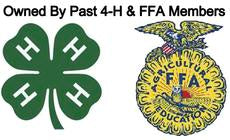Small Acreage Pasture Management: Part II
One of the first considerations in any grazing system is stock water. Its availability will dictate which pastures you can utilize. Some grazing systems drag tanks from paddock to paddock, but a more permanent water point that incorporates cross-fencing or a common lane to water more than one paddock at a time is more convenient. It lets you keep a closer eye on the water source and cuts down the time involved in managing it. If you’re in a cold winter region, don’t forget to run electricity to the tank location. We all have better things to do than chop ice all winter!
Next, you will need some type of fencing, unless you’re willing to herd your animals from plant to plant. Electric fencing as the most cost-effective method of controlling the time your stock graze a given area. Today there are many types of animal containment systems, and the choices can be daunting. Any system worth its salt will have technical advice available for the potential user; maybe even on-the-ground help. Don’t hesitate to ask for help with a grazing plan, watering plan, and fence design and placement.
There are fencing configurations that allow control of many species, including horses, cattle, sheep and goats. Another factor that will influence the fence design is the presence of wildlife. A fence that must coexist with deer or elk may have a substantially different design that one that does not. Let’s look closer at some specific designs.
Perimeter Fencing
For the perimeter of the pasture, use permanent, multi-strand, high-tensile electric systems. The number of wires will vary according to the livestock you wish to contain. Horses and mature cattle can quite often get by with three wires, while small calves, sheep and goats may take five or six.
The best posts to use in areas with snow loads and wildlife has been proven to be solid fiberglass. There are no plastic insulators to break, and the flexibility of the post helps to overcome side loads.
There are two common mistakes that people tend to make when trying high-tensile fencing for the first time:
Posts too close!
Wires too tight!
Post spacings of around 50 feet are adequate because of the nature of high-tensile wire. The wires should be tightened just to the point of removing most of the sag between posts (around 150 to 200 lbs. per wire). This accomplishes two things. First, this design is flexible, allowing the fence to absorb wildlife pressure and snow loads without breaking. Second, less materials are needed so the initial purchase cost and the labor required to install the electric fence is less than conventional fencing.
Interior Cross-fencing
A mixture of high-tensile permanent and portable polywires and tapes often prove to be the best choices for cross fences. Try to create paddocks by placing several permanent cross-fences on obvious topographical changes, not forgetting to include stockwater inside the paddock, or access down a lane to the water. If you are grazing irrigated pasture, ditches can also be your water source. Two wires are usually adequate for mature cattle and larger calves, while three wires are a better choice for horses or cattle with smaller calves.
Use portable polywires and polytapes on handy reels for your internal fencing. There are many portable post types to choose from. Plastic treadins with multiple wire lugs to be the most adaptable. They can be placed on 30-50 foot spacings, and the wires tightened by hand. On irrigated pasture with horses and mature cattle, one charged wire may be sufficient, but when on dry soils or winter-grazing on frozen soil or dry snow, you may need to use several wires, alternating the polarity between hot – ground – hot, etc. By carrying the ground out to the animal via a wire, you remove poor grounding as a source of problems.
Try not to graze and rest each paddock the same number of days regardless of the growth stage of the forage. Aim for the shortest grazing period per paddock needed to harvest the available forage, say one to four days, then a minimum 30 day rest period during fast plant growth. As plant growth slows, then adjust to five to ten days grazing and 60 to 80 days of rest per paddock. You can see why multiple paddocks are needed to reach these levels of rest, but by subdividing with portable electric fencing, it becomes achievable.
There are also a few things to consider that really help in maintenance and troubleshooting. The first is how the fences are energized. The heart of any electric fence system is the power source, or energizer. A 110-volt plug-in energizer versus a battery or solar unit is generally the best choice. More of your dollars can go to power and not batteries, solar panels, etc.
A battery unit is a great choice if you don’t have 110-volt power available. Also, get specific recommendations as to the size of the energizer by matching it to the job at hand: How long is the perimeter fence? What type of animal are you controlling? Does the fence run through high vegetation? Will you add on to the system eventually? All these questions will help your supplier match an energizer to your needs.
Lastly, consider investing in a digital voltmeter designed to monitor your fences and energizer. They are handheld meters that measure the voltage output of the energizer, or at any point along the fenceline. They are invaluable in diagnosing any problems that may crop up.
I hope this gives you a bit of familiarity with what equipment and techniques are available to help in establishing your grazing plan. There is definitely a bit of work and a learning curve involved, but seeing your critters hock-deep in lush grass while your neighbors are forking hay (and forking out dollars, too!) can be priceless!
Please order online 24/7 or callVALLEY FARM SUPPLYat 717-786-0368





